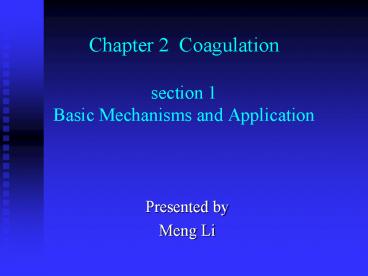Chapter 2 Coagulation section 1 Basic Mechanisms and Application - PowerPoint PPT Presentation
1 / 19
Title:
Chapter 2 Coagulation section 1 Basic Mechanisms and Application
Description:
Title: Aluminum-Fulvic Interactions: mechanisms and Application Author: limeng Last modified by: lm Created Date: 1/13/2003 3:24:38 AM Document presentation format – PowerPoint PPT presentation
Number of Views:158
Avg rating:3.0/5.0
Title: Chapter 2 Coagulation section 1 Basic Mechanisms and Application
1
Chapter 2 Coagulationsection 1Basic
Mechanisms and Application
- Presented by
- Meng Li
2
Review
- Basic processes of water treatment
Coagulation
sedimentation
filtration
sedimentation
disinfection
Treated water
3
Outlines of this class
- 1 basic concepts of coagulation
- 2 backgrounds for Alum chemistry
- 3 interaction between colloidal particles and
coagulants - 4 main factors of particles removal efficiency
4
Basic concepts of coagulation
- 1 destabilization(?????)
- Particles lose their stability through charge
neutralization - 2 aggregation(??)
- After destabilization, particles collide with
each other and form larger particles - 3 coagulation(??)
- Destabilization Aggregation
5
Backgrounds For Aluminum Chemistry
- Several Al coagulants are used widely for
removing contaminants in the raw water AlCl3,
Al2(SO4)3.nH2O and PACl. - The classes of Al species can be divided into
four categories Monomers and small polymers
such as Al and Al(OH)4- medium polymers, such as
Al7(OH)174 large polymers, such as Al13(OH)347
and Al(OH)3 Solids precipitate. And the
solubility of Aluminum in equilibrium with solid
Al(OH)3 will be greatly depend on the surrounding
PH and the concentration of Aluminum.
6
Background for colloidal particles
- Average particle size
- 10-9 m
- High charge density
- Small molecular weight
- Hard to be removed
7
Backgrounds for colloidal particles(2)
- Carboxyl(??) and phenolic groups(??) provide most
of the negative charge that adds to the mobility
of colloidal particles in the raw water. - Apparently water quality problems related to
these colloidal particles are color, taste and
odor, corrosion and biological activity in water
distribution systems, mobilization of toxic
elements and micro-pollutants, and the formation
of disinfection by-products such as THMs. - Humic substances have a great tendency to adsorb
to particles and increase their charges and
stability.
8
Basic machanisms of coagulation
- Two important mechanisms for colloidal particles
removal are - (1) Charge neutralization-precipitation(CNP). The
CNP consists of the reaction between soluble Al
cationic polymers and soluble anionic particles,
that is to say, adsorption of positively charged
coagulant species to sites on the negatively
charged fulvic acid to obtain charge
neutralization and formation of insoluble
complexes. Obviously there exists a chemistry
stoichimetry(????) between coagulant dosage and
particles and re-stabilization region resulting
from charge reversal should be possible upon
overdosing. This mechanisms is generally more
dominant during the low PH value.
9
Continue
- (2) Adsorption and simultaneous precipitate( or
sweep coagulation), that is to say, adsorption of
colloidal particles to, or enmeshment in, Alum
hydroxide precipitates. The bonds that form can
include van der walls interactions, H-bonding,
hydrophobic bonding and ligand exchange. And
simultaneous precipitation can be considered to
be the simultaneous reaction of FA particles with
both soluble Al polymers and Al(OH)3. This
mechanism is more dominant at higher PH value.
10
Aluminum speciation diagram for AlCl3
11
- From this picture
- The data cover a PH range from 4.75 to 8.0. At a
low PH, monomeric and small polymeric dominate.
Then, as the PH increases, the medium polymers
become dominant at P H 6-6.5. Concurrently,
Al(OH)3 increases while the concentration of
predominant Al species is Al(OH)3. As PH 8 is
approached, an increase in monomers is observed
along with a decrease in the Al(OH)3 due to the
presence of Al(OH)3 at higher PH.
12
Aluminum speciation diagram for Alum Sulfate
13
- From this picture
- In terms of speciation diagram for alum sulfate,
the Al species distribution is distinctly
different from that for AlCl3. Monomer and small
polymers concentration decrease sharply at PH 5.
As PH increases to 6.9, the formation of Al(OH)3
increases rapidly. The rapid formation of Al(OH)3
is attributed to the presence of sulfate. Sulfate
causes Al(OH)3 to be formed at lower PH values.
14
Aluminum speciation diagram for PACl
15
From this picture 1 The monomer and small
polymer are dominant at low PH and medium polymer
are predominant at PH5.0-6.6. Beyond PH6.6 an
Al(OH)3 precipitates forms and then the
concentration of Al(OH)3 exceeds that of the
medium polymers. 2 The distribution of Al
species between PH 5.5 and 6.5 is representative
of the initial concentrated Al solution.at lower
PH,some small and medium polymers seem to be
dissolved to form monomers.
16
Discussion
- 1 The mechanisms of colloidal particles removal
are directly related to the formation of Al
speciation in solution. Charge neutralization-prec
ipitation occurs in the presence of Al monomers
and polymers. Adsorption takes place when Al(OH)3
has precipitated from solution. At higher PH
value at which both Al(OH)3 and Al polymers
coexist, concurrent reactions by both mechanisms
appear to cause simultaneous precipitation.
17
Continue
- 2 Different Al coagulants have been shown to have
different Al species distributions over a wide
range of PH, which cause different mechanisms of
particles removal under the same conditions. So
analyzing Al species is useful by providing
insights into the reactions mechanisms between
colloidal particles and chemicals in the
suspensions.
18
Continue
- 3 The use of PACl has been shown to be beneficial
at low particle concentrations and low PH,
producing better removals of FA than the other
kinds of coagulants. - 4 The addition of Ca during water treatment may
be a cost-effective means of improving particle
removal. - 5 For particles from different sources, there
does exist different removal effects. The
influencing factors may include particle
molecular weight, charge density and components
and structures of particles.
19
Main content of this class
- 1 basic theory of coagulation
- 2 influencing factors of coagulation process
- 3 interaction between colloidal particles and
coagulants

